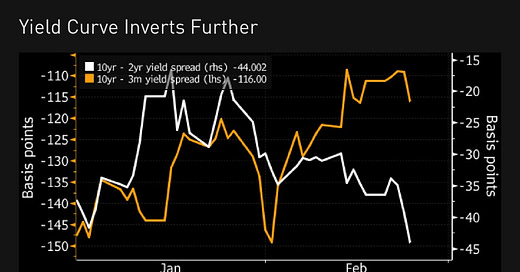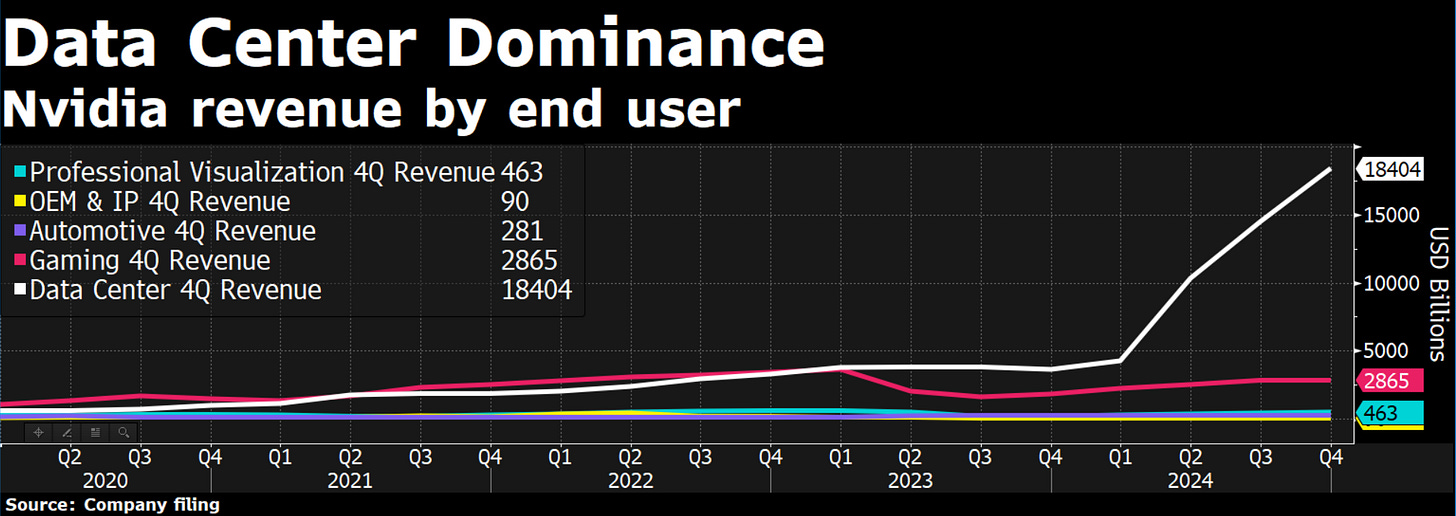Weekly Good Reads: 5-1-1
Nvidia, FOMC minutes, Japan, Self-Insight, Commodities Performance, Data Centre
Welcome to Weekly Good Reads 5-1-1 by Marianne O, a 25-year investment practitioner and the author of
on investing, economy, and wellness in an intuitive voice. All the Weeklies are here, and here is the index of charts and terms. You can easily subscribe to my newsletter by clicking below.Thank you so much for your support🙏.
Market and Data Comments
A few key events characterised the data-light week.
First, the FOMC minutes and Fed speech in the past week showed a broad concern at the Fed for easing too early and for financial conditions being too loose, which may stall the gain from disinflation. The Fed also expressed some scepticism towards the permanence of the rapid productivity gains (averaging 3.9% in the last 3 quarters) which may allow companies to raise wages without raising prices.
Second, Nvidia produced a third straight quarter of forecast-beating results (265% increase in revenue y-o-y) as almost everyone demands its chips for AI technology, propelling its valuation towards $2 trillion in just about eight months. BofA’s Michael Hartnett said “…a rally in artificial intelligence stocks and optimism about economic growth at a time of easing monetary policy are the ingredients of a “magic sauce” to drive more gains in equity markets.” (Read more in Econ/Invest. #1.)
Third, with the boost of demand for AI, stocks (up around 1.5% this week) and economic growth continue to climb while the yield curve inverts further with 10-year to 2-year US government bond spread at -44bp (vs. -37bp at 2023-end) (see chart above). Note that the 5Y to 30Y part of the yield curve is still normal (upward-sloping) implying the inverted yield curve occurs at the shorter end and could normalize as the pace of rate-cutting by the Fed is clearer.
Fourth, last Thursday, the Japan Nikkei Index climbed above its previous record set 34 years ago on December 29, 1989. The gain has been fuelled by (1) improved profitability in the manufacturing sector (especially auto), which was up 20% on the year during the April to December period (2) the Tokyo Stock Exchange’s pressure on the CEOs to improve corporate governance, and (3) foreign capital redirected from China into Japan.
This coming week we will monitor the US revised Q4 GDP on Wednesday, January personal spending and core PCE index on Thursday, and February ISM manufacturing PMI on Friday, Japan’s February CPI on Monday, Euro Area February inflation on Friday as well as the February manufacturing PMI in the UK, China, and the Euro Area on Friday.

Economy and Investments (Links):
Related: Nvidia shatters stock market record by adding over $230 billion in value in one day. Here’s why it’s dominating the AI chip race (Fortune)
Berkshire Hathaway 2023 Shareholders Newsletter (Berkshire Hathaway)
One investment rule at Berkshire has not and will not change: Never risk permanent loss of capital. Thanks to the American tailwind and the power of compound interest, the arena in which we operate has been – and will be – rewarding if you make a couple of good decisions during a lifetime and avoid serious mistakes. (Berkshire Hathaway 2023)
Finance/Wealth (Link):
Accounting for Inflation in Retirement and FIRE Planning (Best Interest)
+ At the Money: Why Self-Insight Is So Important - Podcast with David Dunning, a professor of psychology at the University of Michigan (The Big Picture)
N.B. Professor Dunning is the Dunning in the Dunning Kruger, and here is his answer to the question: how can we know ourselves better?
…as we progress in the twenty-first century, dealing with information is going to be the skill that we all need. Finding experts and evaluating experts – Who is an expert? – is gonna be a skill that we all need. Figuring out if we’re expert enough is gonna be a skill that we all need. And a lot of that is really about being able to evaluate the information that we confront and a lot of that really boils down to fact checking and journalism. So, finding out how to do that, I wish we have a little bit more of those skills, as a country or at least that that that’s the the nudge that I would give people.
Wellness/Idea (Link):
1 big thing: Test your power (Axios Finish Line)
Test your power: Sit in a chair with a straight back, without arm rests, and set a timer for 30 seconds. Get up and sit back down as many times as you can in that period.
Build your power. One effective exercise is squatting, a movement that mimics life. Adding squats to your exercise routine will help you when you're cooking, gardening, playing with the kids or lifting things at work.
+ Sustained Elevation (Friday Forward by
)One Chart You Should Not Miss: Commodities that Benefit the Most from Fed-Induced Rate Cuts
According to Goldman Sachs’s research, the immediate price boost from a Fed-driven (Fed-induced rather than slower GDP growth) 100bp decline in US 2-year interest rates is the largest for metals especially copper (6%), followed by gold (3%) and oil (3%).
Goldman concludes that under their central “soft landing” scenario—the Fed cuts as core inflation slows but growth is solid—industrial metals, and especially copper, should offer attractive returns while under a no-landing scenario, demand for inflation hedges should continue to benefit oil and oil products.
One Term To Know: Data Centre
A data center is a physical location that stores computing machines and their related hardware equipment. It contains the computing infrastructure that IT systems require, such as servers, data storage drives, and network equipment that stores any company’s digital data (AWS).
A data centre is important to a business because a company needs computing equipment to run its web applications, offer services to customers, sell products, or run internal applications. As the business grows, the need for IT equipment grows. With a data centre, a company can concentrate its devices on a central location or use third-party data centres.
A company such as Nvidia has benefitted from the rise in data centres because its GPUs (graphics processing units) are employed in data centres for their exceptional ability to perform parallel data processing that enables breakthrough performance with fewer and more powerful servers. As a result, GPUs are perfect for tasks such as scientific computations, machine learning algorithms, and processing big data.
Nvidia’s data centre platform is the world’s leading accelerated computing solution, used by the largest enterprises and supercomputing centres (Nvidia).
From the chart below, Nvidia’s data centre revenue has surged and become dominant since fiscal calendar Q1 2024 or the beginning of calendar year 2023 (its fiscal year ends in January). It is estimated Nvidia has over 70% of the data centre market share (the data centre market has grown at 30% CAGR since 2019).
Please do not hesitate to get in touch if you have any questions! If you like this weekly, please share it with your friends or subscribe to my newsletter.
👋 This year, I am sharing my conversations with female fund managers, investors, founders, technologists and more! Subscribe to follow.
Here’s the latest conversation I had with Chief Investment Officer, U-Wen Kok.
Thank you so much for reading and supporting my work 🙏.









